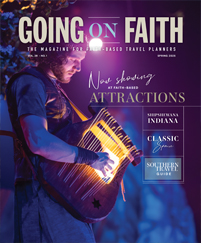Savannah, Georgia
The original charter for the Georgia Trustees, granted in 1732, said all colonists “shall have a free exercise of their religion.” Because of that religious freedom, “what has happened over the centuries, it’s really become a beautiful tapestry of different denominations,” said Mindy Shea, director of tour, travel and international sales for Visit Savannah.
Total religious freedom wasn’t the case. The charter specifically denied Catholics the right to worship in the colony, and the Georgia Trustees also originally banned Judaism, according to the Georgia Historical Society.
But when a ship with Jewish passengers docked, Gen. James Oglethorpe allowed them to stay and even allowed them to own land. The Jewish settlers founded the Congregation Mickve Israel, the third-oldest Jewish congregation in America and the oldest in the South. The Gothic-style synagogue sits on Monterey Square, and groups can take guided tours of both its sanctuary and its museum, where they’ll see the two oldest Torahs in North America and the congregation’s collection of letters from 13 presidents, including George Washington.
Christ Church, built in 1733, was the first church formed in Savannah and still rings the bell hung by Revere and Son from Boston. The First African Baptist Church congregation was organized in 1773, but the building was completed in 1859. After working all day on plantations and in fields, slaves walked to the site and “built this church brick by brick in the dead of night,” Shea said. The church subsequently became a stop on the Underground Railroad.
Although it got a later start in Savannah than other religions, Catholicism took root in Georgia after the American Revolution. Groups can visit the late-1800s Cathedral of St. John the Baptist during self-guided or docent-led tours, and they can also attend daily mass there.
Elko, Nevada
Whether they were searching for land, gold or a fresh start, an estimated 250,000 people made their way to California between 1841 and 1869, and the California Trail led them through what is today Elko, Nevada.
At the California Trail Interpretive Center, groups can see covered wagons, learn about pioneer life and hike the nature trails surrounding the museum to take in views of the Ruby Mountains, “which are gorgeous and beautiful,” said Tom Lester, tourism and convention manager for the Elko Convention and Visitors Authority. Lester recently arranged for a group to go hiking in the mountains and then enjoy a Dutch-oven-cooked lunch. For the annual Trail Days at the center, visitors can experience live re-enactments of pioneer life at an 1850s-era wagon encampment and re-created Shoshone summer camp.
The Western Folklife Center is the National Cowboy Poetry Gathering’s headquarters. Although the annual festival is a busy time for groups to visit, the city is a year-round home to cowboy artists and poets that perform at events. Housed in the historic Pioneer Hotel in downtown, the center displays pieces from its permanent collection, rotates temporary exhibits and has a historic bar and dance floor for groups and events.
Across the street at J.M. Capriola Co., groups can watch custom saddles being made. The Cowboy Arts and Gear Museum, in the former home of G.S. Garcia Saddle Co., is being renovated to its 1800s appearance and is slated to reopen November 1. During the remodel, groups can work with the museum director to schedule a leather-tooling class at J.M. Capriola.
The Northeastern Nevada Museum houses extensive collections of Western art and exhibits of Nevada’s history and wildlife.
Plymouth, Massachusetts
Plymouth Rock is nestled in the sand on the shore of Plymouth Harbor, “1620” chiseled into its surface. No evidence exists that this boulder was the landing spot where the Pilgrims stepped into the New World — only a story passed down from one of the original Mayflower passengers that identified it 121 years after the Mayflower arrived.
That doesn’t make it any less of an icon for visitors to Plymouth, Massachusetts, the site of the first Pilgrim settlement that also served as the capital of the colony.
Plymouth is preparing for its 400th anniversary in 2020 with plans for festivities and fanfare, and Pilgrim Memorial State Park, the site of Plymouth Rock, will be revamped, said Paula Fisher, marketing director for Destination Plymouth.
Plimoth Plantation is the city’s most-visited site, and the living-history village is a re-creation of what Pilgrims would have built in their first few years in the village. Re-enactors wearing period costume show visitors to the 17th-century English village and the Wampanoag Homesite what life was like at the time.
The Plymouth Antiquarian Society owns and maintains three historic homes that are open for tours, and historic walking tours or step-on guides are available. Groups can take guided tours of the First Parish Meetinghouse, which is the fifth building to sit on the site of the first meetinghouse, built in 1621, or visit Burial Hill next door and the Plimoth Grist Mill across the street.
Thousands of people descend on Plymouth for Thanksgiving, and the city welcomes them with the weeklong America’s Hometown Celebration, which features a parade, a food festival, a harvest market, concerts and living-history experiences.










